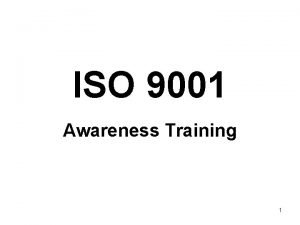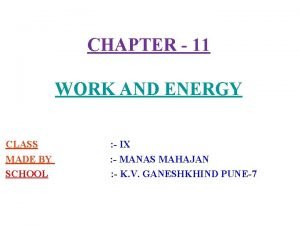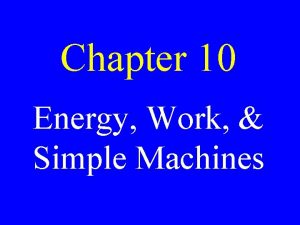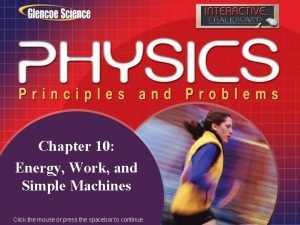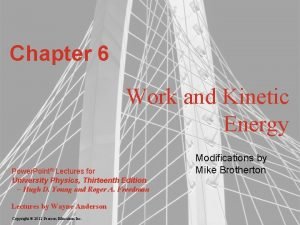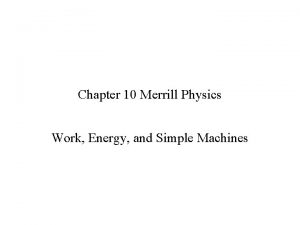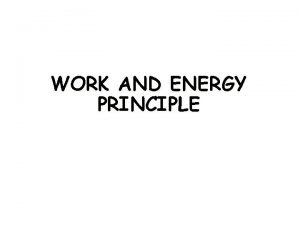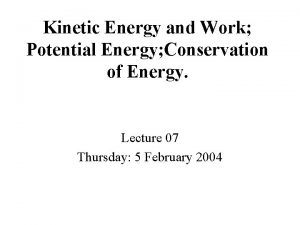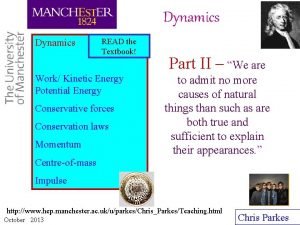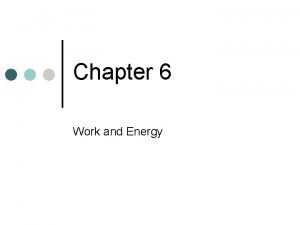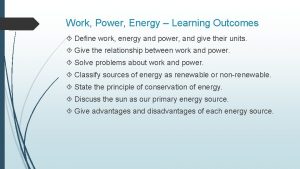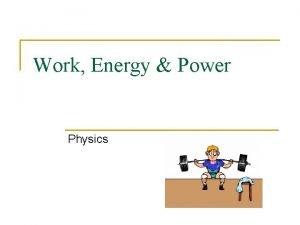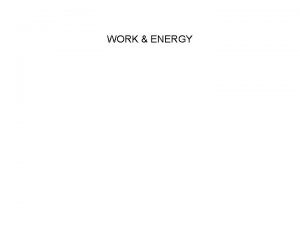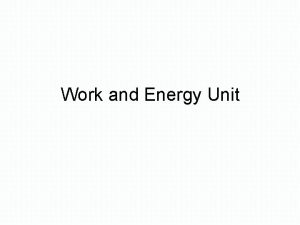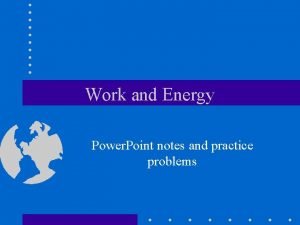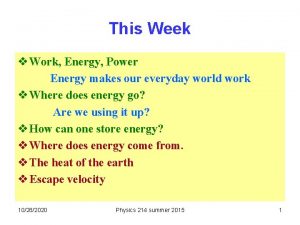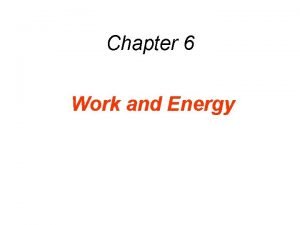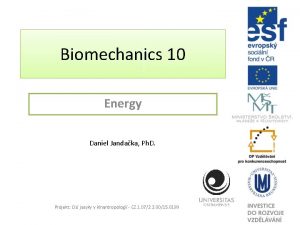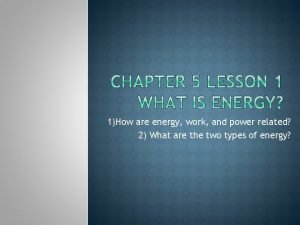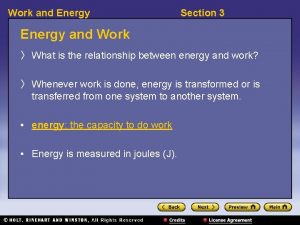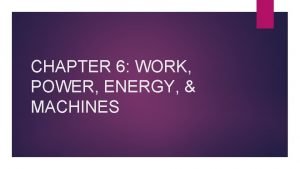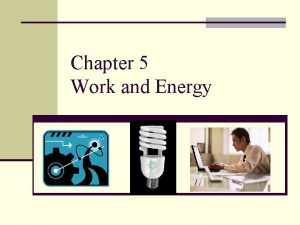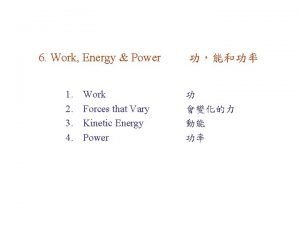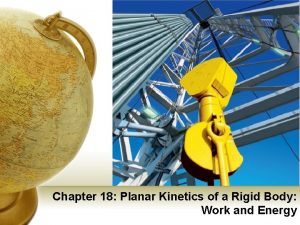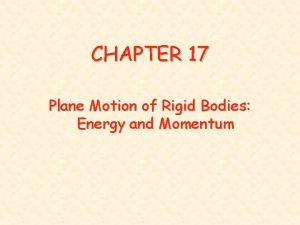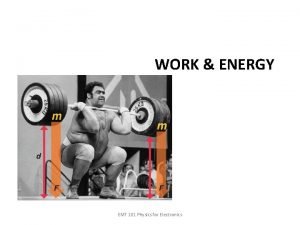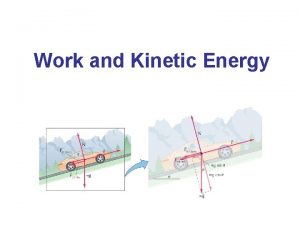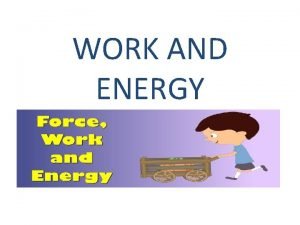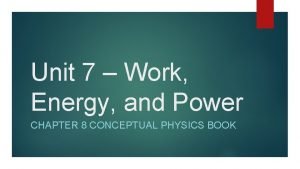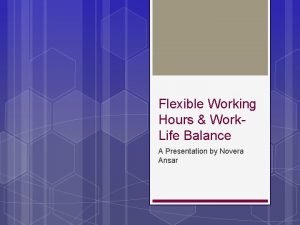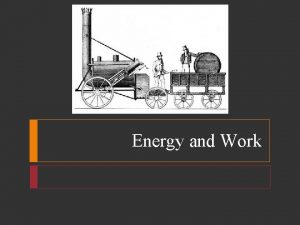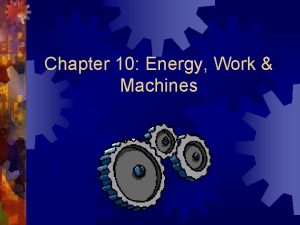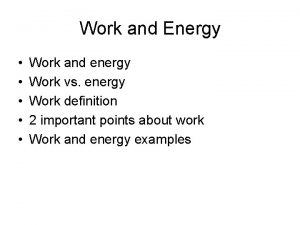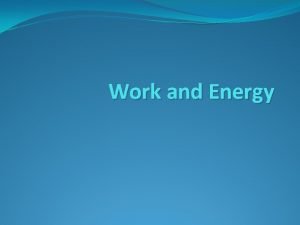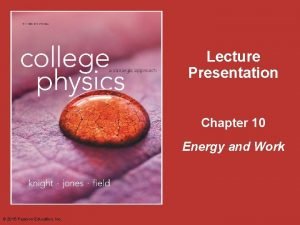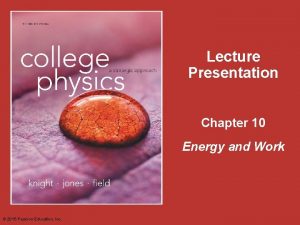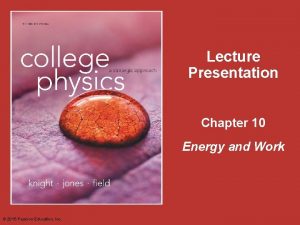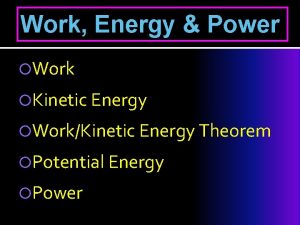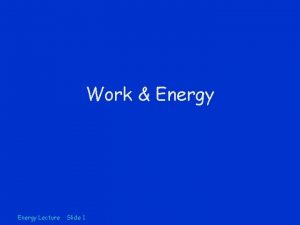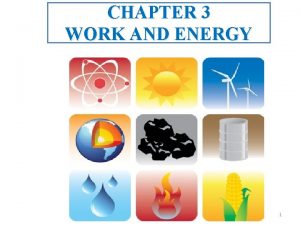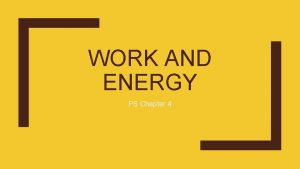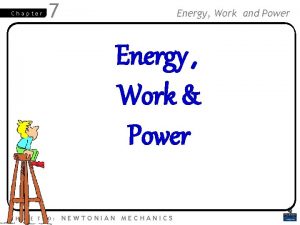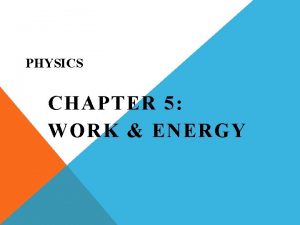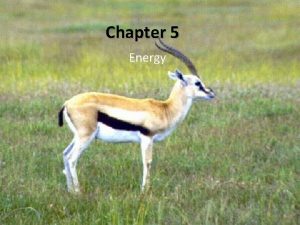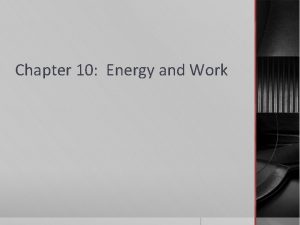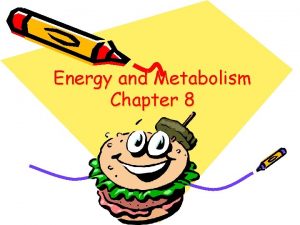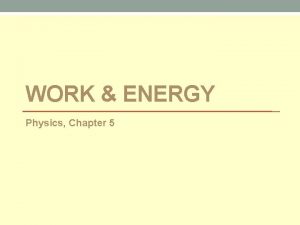Lecture Presentation Chapter 10 Energy and Work 2015


























































- Slides: 58

Lecture Presentation Chapter 10 Energy and Work © 2015 Pearson Education, Inc.

Chapter 10 Energy and Work Chapter Goal: To introduce the concept of energy and to learn a new problem-solving strategy based on conservation of energy. © 2015 Pearson Education, Inc. Slide 10 -2

Chapter 10 Preview Looking Ahead: Forms of Energy • This dolphin has lots of kinetic energy as it leaves the water. At its highest point its energy is mostly potential energy. • You’ll learn about several of the most important forms of energy—kinetic, potential, and thermal. © 2015 Pearson Education, Inc. Slide 10 -3

Chapter 10 Preview Looking Ahead: Work and Energy • As the band is stretched, energy is transferred to it as work. This energy is then transformed into kinetic energy of the rock. • You’ll learn how to calculate the work done by a force, and how this work is related to the change in a system’s energy. © 2015 Pearson Education, Inc. Slide 10 -4

Chapter 10 Preview Looking Ahead: Conservation of Energy • As they slide, their potential energy decreases and their kinetic energy increases, but their total energy is unchanged: It is conserved. • How fast will they be moving when they reach the bottom? You’ll use a new before-and-after analysis to find out. © 2015 Pearson Education, Inc. Slide 10 -5

Chapter 10 Preview Looking Back: Motion with Constant Acceleration In Chapter 2 you learned how to describe the motion of a particle that has a constant acceleration. In this chapter, you’ll use the constant-acceleration equations to connect work and energy. A particle’s final velocity is related to its initial velocity, its acceleration, and its displacement by © 2015 Pearson Education, Inc. Slide 10 -6

Chapter 10 Preview Stop to Think A car pulls away from a stop sign with a constant acceleration. After traveling 10 m, its speed is 5 m/s. What will its speed be after traveling 40 m? A. B. C. D. 10 m/s 20 m/s 30 m/s 40 m/s © 2015 Pearson Education, Inc. Slide 10 -7

Chapter 10 Preview Stop to Think A car pulls away from a stop sign with a constant acceleration. After traveling 10 m, its speed is 5 m/s. What will its speed be after traveling 40 m? A. B. C. D. 10 m/s 20 m/s 30 m/s 40 m/s © 2015 Pearson Education, Inc. Slide 10 -8

Section 10. 1 The Basic Energy Model © 2015 Pearson Education, Inc.

The Basic Energy Model Every system in nature has a quantity we call its total energy E. © 2015 Pearson Education, Inc. Slide 10 -10

Forms of Energy Some important forms of energy are • Kinetic energy K: energy of motion. • Gravitational potential energy Ug: stored energy associated with an object’s height above the ground. • Elastic or spring potential energy Us: energy stored when a spring or other elastic object is stretched. • Thermal energy Eth: the sum of the kinetic and potential energies of all the molecules in an object. • Chemical energy Echem: energy stored in the bonds between molecules (potential energy). • Nuclear energy Enuclear: energy “stored” in the mass of the nucleus of an atom (E = mc 2). © 2015 Pearson Education, Inc. Slide 10 -11

Energy Transformations Energy of one kind can be transformed into energy of another kind within a system. © 2015 Pearson Education, Inc. Slide 10 -12

Energy Transformations The weightlifter converts chemical energy in her body into gravitational potential energy of the barbell. © 2015 Pearson Education, Inc. Elastic potential energy of the springboard is converted into kinetic energy. As the diver rises into the air, this kinetic energy is transformed into gravitational potential energy. Slide 10 -13

Quick. Check 10. 1 A child is on a playground swing, motionless at the highest point of his arc. What energy transformation takes place as he swings back down to the lowest point of his motion? A. B. C. D. E. K Ug Ug K Eth K Ug Eth K Eth © 2015 Pearson Education, Inc. Slide 10 -14

Quick. Check 10. 1 A child is on a playground swing, motionless at the highest point of his arc. What energy transformation takes place as he swings back down to the lowest point of his motion? A. B. C. D. E. K Ug Ug K Eth K Ug Eth K Eth © 2015 Pearson Education, Inc. Slide 10 -15

Quick. Check 10. 2 A skier is gliding down a gentle slope at a constant speed. What energy transformation is taking place? A. B. C. D. E. K Ug Ug K Eth K Ug Eth K Eth © 2015 Pearson Education, Inc. Slide 10 -16

Quick. Check 10. 2 A skier is gliding down a gentle slope at a constant speed. What energy transformation is taking place? A. B. C. D. E. K Ug Ug K Eth K Ug Eth K Eth © 2015 Pearson Education, Inc. Slide 10 -17

Energy Transfers and Work • Energy can be transferred between a system and its environment through work and heat. • Work is energy transferred mechanically to or from a system by a force pushing or pulling on it. (W) • Heat is the energy transferred non-mechanically between a system and the environment due to a temperature difference between the two. (Q) © 2015 Pearson Education, Inc. Slide 10 -18

Energy Transfers and Work The athlete does work on the shot, giving it kinetic energy, K. © 2015 Pearson Education, Inc. The hand does work on the match, giving it thermal energy, Eth. The boy does work on the slingshot, giving it elastic potential energy, Us. Slide 10 -19

Quick. Check 10. 3 A tow rope pulls a skier up a slope at constant speed. What energy transfer (or transfers) is taking place? A. B. C. D. E. W Ug W K W Eth Both A and B. Both A and C. © 2015 Pearson Education, Inc. Slide 10 -20

Quick. Check 10. 3 A tow rope pulls a skier up the slope at constant speed. What energy transfer (or transfers) is taking place? A. B. C. D. E. W Ug W K W Eth Both A and B. Both A and C. © 2015 Pearson Education, Inc. Slide 10 -21

The Work-Energy Equation • In mechanics (no heat transfer), work represents energy that is transferred into or out of a system. • The total energy of a system changes by the amount of work done on it (if no heat added/removed). • Work can increase or decrease the energy of a system. • If no energy is transferred into or out of a system, that is an isolated system. © 2015 Pearson Education, Inc. Slide 10 -22

The Law of Conservation of Energy The total energy of an isolated system remains constant. © 2015 Pearson Education, Inc. Slide 10 -23

Reading Question 10. 1 If a system is isolated, the total energy of the system A. B. C. D. E. Increases constantly. Decreases constantly. Is constant. Depends on the work into the system. Depends on the work out of the system. © 2015 Pearson Education, Inc. Slide 10 -24

Reading Question 10. 1 If a system is isolated, the total energy of the system A. B. C. D. E. Increases constantly. Decreases constantly. Is constant. Depends on the work into the system. Depends on the work out of the system. © 2015 Pearson Education, Inc. Slide 10 -25

Section 10. 2 Work © 2015 Pearson Education, Inc.

Work is done on a system by external forces: forces from outside the system. © 2015 Pearson Education, Inc. Slide 10 -27

Calculating Work • For this formula, both the force and displacement vectors must point in exactly the same direction. • Although both the force and the displacement are vectors, work is a scalar. • The unit of work (and energy) is: © 2015 Pearson Education, Inc. Slide 10 -28

Example 10. 1 Work done in pushing a crate Sarah pushes a heavy crate 3. 0 m along the floor at a constant speed. She pushes with a constant horizontal force of magnitude 70 N. How much work does Sarah do on the crate? © 2015 Pearson Education, Inc. Slide 10 -29

Example 10. 1 Work done in pushing a crate Sarah pushes a heavy crate 3. 0 m along the floor at a constant speed. She pushes with a constant horizontal force of magnitude 70 N. How much work does Sarah do on the crate? © 2015 Pearson Education, Inc. Slide 10 -30

Example 10. 1 Work done in pushing a crate (cont. ) Sarah pushes with a constant force in the direction of the crate’s motion, so we can use Equation 10. 5 to find the work done. PREPARE SOLVE The work done by Sarah is W = Fd = (70 N)(3. 0 m) = 210 J ASSESS By pushing on the crate Sarah increases its kinetic energy, so it makes sense that the work done is positive. © 2015 Pearson Education, Inc. Slide 10 -31

Reading Question 10. 4 If you hold a heavy weight over your head, the work you do while holding the weight A. B. C. D. E. Is greater than zero. Is less than zero. Is converted into chemical energy. Is converted into potential energy. © 2015 Pearson Education, Inc. Slide 10 -32

Reading Question 10. 4 If you hold a heavy weight over your head, the work you do while holding the weight A. B. C. D. E. Is greater than zero. Is less than zero. Is converted into chemical energy. Is converted into potential energy. © 2015 Pearson Education, Inc. Slide 10 -33

Force at an Angle to the Displacement • Only the component of a force in the direction of displacement does work. • If the force is at an angle θ to the displacement, the component of the force, F, that does work is Fcosθ. © 2015 Pearson Education, Inc. Slide 10 -34

Force at an Angle to the Displacement © 2015 Pearson Education, Inc. Slide 10 -35

Force at an Angle to the Displacement © 2015 Pearson Education, Inc. Slide 10 -36

Force at an Angle to the Displacement The sign of W is determined by the angle θ between the force and the displacement. © 2015 Pearson Education, Inc. Slide 10 -37

Quick. Check 10. 5 Robert pushes the box to the left at constant speed. In doing so, Robert does ______ work on the box. A. positive B. negative C. zero © 2015 Pearson Education, Inc. Slide 10 -38

Quick. Check 10. 5 Robert pushes the box to the left at constant speed. In doing so, Robert does ______ work on the box. A. positive B. negative C. zero Force is in the direction of displacement positive work © 2015 Pearson Education, Inc. Slide 10 -39

Quick. Check 10. 4 • A crane lowers a girder into place at constant speed. Consider the work Wg done by gravity and the work WT done by the tension in the cable. Which is true? A. B. C. D. E. Wg > 0 and WT > 0 Wg > 0 and WT < 0 Wg < 0 and WT > 0 Wg < 0 and WT < 0 Wg = 0 and WT = 0 © 2015 Pearson Education, Inc. Slide 10 -40

Quick. Check 10. 4 • A crane lowers a girder into place at constant speed. Consider the work Wg done by gravity and the work WT done by the tension in the cable. Which is true? A. B. C. D. E. Wg > 0 and WT > 0 Wg > 0 and WT < 0 Wg < 0 and WT > 0 Wg < 0 and WT < 0 Wg = 0 and WT = 0 © 2015 Pearson Education, Inc. The downward force of gravity is in the direction of motion positive work. The upward tension is in the direction opposite the motion negative work. Slide 10 -41

Quick. Check 10. 6 A constant force pushes a particle through a displacement. In which of these three cases does the force do negative work? D. Both A and B. E. Both A and C. © 2015 Pearson Education, Inc. Slide 10 -42

Quick. Check 10. 6 A constant force pushes a particle through a displacement. In which of these three cases does the force do negative work? D. Both A and B. E. Both A and C. © 2015 Pearson Education, Inc. Slide 10 -43

Quick. Check 10. 7 Which force below does the most work? All three displacements are the same. A. B. C. D. The 10 N force. The 8 N force The 6 N force. They all do the same work. © 2015 Pearson Education, Inc. sin 60 = 0. 87 cos 60 = 0. 50 Slide 10 -44

Quick. Check 10. 7 Which force below does the most work? All three displacements are the same. A. B. C. D. The 10 N force. The 8 N force The 6 N force. They all do the same work. © 2015 Pearson Education, Inc. sin 60 = 0. 87 cos 60 = 0. 50 Slide 10 -45

Example 10. 2 Work done in pulling a suitcase A strap inclined upward at a 45° angle pulls a suitcase through the airport horizontally along the floor. The tension in the strap is 20 N. How much work does the tension do if the suitcase is pulled 100 m at a constant speed? © 2015 Pearson Education, Inc. Slide 10 -46

Example 10. 2 Work done in pulling a suitcase A strap inclined upward at a 45° angle pulls a suitcase through the airport. The tension in the strap is 20. N. How much work does the tension do if the suitcase is pulled 100. m at a constant speed? © 2015 Pearson Education, Inc. Slide 10 -47

Example 10. 2 Work done in pulling a suitcase (cont. ) Since the suitcase moves at a constant speed, there must be a rolling friction force (not shown) acting to the left. PREPARE We can use W = Fd cos , with F T, to find the work done: W = Td cos = (20 N)(100 m)cos 45° = 1400 J SOLVE ASSESS The tension is needed to do work to overcome friction, so it makes sense that the work is positive. The work done goes entirely into thermal energy. © 2015 Pearson Education, Inc. Slide 10 -48

Forces That Do No Work A force does no work on an object if • The object undergoes no displacement. • The force is perpendicular to the displacement. • The part of the object on which the force acts undergoes no displacement (even if other parts of the object do move). Text: p. 291 © 2015 Pearson Education, Inc. Slide 10 -49

Quick. Check 10. 8 I swing a ball around my head at constant speed in a circle with circumference 3. 1 m. What is the work done on the ball by the 10. N tension force in the string during one revolution of the ball? A. B. C. D. 31 J 16 J 10. J 0. 0 J © 2015 Pearson Education, Inc. Slide 10 -50

Quick. Check 10. 8 I swing a ball around my head at constant speed in a circle with circumference 3. 1 m. What is the work done on the ball by the 10. N tension force in the string during one revolution of the ball? A. B. C. D. 31 J 16 J 10. J 0. 0 J © 2015 Pearson Education, Inc. The string provides centripetal acceleration which is perpendicular to the ball’s direction of motion. Slide 10 -51

Section 10. 3 Kinetic Energy © 2015 Pearson Education, Inc.

Kinetic Energy • Kinetic energy is energy of motion. • Kinetic energy can be in two forms: translational, for motion of an object along a path; and rotational, for the motion of an object around an axis. • When only Kinetic energy is relevant (i. e. all other types of energy are not changing), ΔK = ΔE, and so the workenergy equation becomes W = ΔK = Kf Ki. © 2015 Pearson Education, Inc. Slide 10 -53

Quick. Check 10. 9 Ball A has half the mass and eight times the kinetic energy of ball B. What is the speed ratio v. A/v. B? A. B. C. D. E. 16 4 2 1/4 1/16 © 2015 Pearson Education, Inc. Slide 10 -54

Quick. Check 10. 9 Ball A has half the mass and eight times the kinetic energy of ball B. What is the speed ratio v. A/v. B? A. B. C. D. E. 16 4 2 1/4 1/16 © 2015 Pearson Education, Inc. Slide 10 -55

Rotational Kinetic Energy • Rotational kinetic energy is a way of expressing the sum of the kinetic energy of all the parts of a rotating object. • In rotational kinetic energy, the moment of inertia takes the place of mass and the angular velocity takes the place of linear velocity. © 2015 Pearson Education, Inc. Slide 10 -56

Example 10. 5 Speed of a bobsled after pushing A two-man bobsled has a mass of 390 kg. Starting from rest, the two racers push the sled for the first 50 m with a net force of 270 N. Neglecting friction, what is the sled’s speed at the end of the 50 m? © 2015 Pearson Education, Inc. Slide 10 -57

Example 10. 5 Speed of a bobsled after pushing (cont. ) Because friction is negligible, there is no change in the sled’s thermal energy. And, because the sled’s height is constant, its gravitational potential energy is unchanged as well. Thus the work-energy equation is simply ΔK = W. We can therefore find the sled’s final kinetic energy, and hence its speed, by finding the work done by the racers as they push on the sled. The figure lists the known quantities and the quantity vf that we want to find. PREPARE The work done by the pushers increases the sled’s kinetic energy. © 2015 Pearson Education, Inc. Slide 10 -58
 Section 4 review physical science
Section 4 review physical science 01:640:244 lecture notes - lecture 15: plat, idah, farad
01:640:244 lecture notes - lecture 15: plat, idah, farad Physics 03-06 impulse and momentum answer key
Physics 03-06 impulse and momentum answer key Smart work and hard work
Smart work and hard work Describing energy section 2 answers
Describing energy section 2 answers Energy energy transfer and general energy analysis
Energy energy transfer and general energy analysis Energy energy transfer and general energy analysis
Energy energy transfer and general energy analysis Iso 9001 presentation
Iso 9001 presentation Iso 9001 2015 awareness training
Iso 9001 2015 awareness training Utilities and energy lectures
Utilities and energy lectures Lecture presentation software
Lecture presentation software Chapter 11 work and energy
Chapter 11 work and energy Chapter 10 energy work and simple machines answer key
Chapter 10 energy work and simple machines answer key Chapter 10 energy, work and simple machines answer key
Chapter 10 energy, work and simple machines answer key Energy work and simple machines chapter 10 answers
Energy work and simple machines chapter 10 answers Chapter 6 work and energy powerpoint
Chapter 6 work and energy powerpoint Chapter 10 work energy and machines
Chapter 10 work energy and machines Sinciput presentation
Sinciput presentation Vertex presentation
Vertex presentation Chapter 7 energy conservation of energy
Chapter 7 energy conservation of energy Dark matter and dark energy ppt
Dark matter and dark energy ppt Human resource management 15th edition
Human resource management 15th edition Chapter 1 introduction to human resource management
Chapter 1 introduction to human resource management Human resource management lecture chapter 1
Human resource management lecture chapter 1 Ads=vdv example
Ads=vdv example Ki + ui = kf + uf
Ki + ui = kf + uf Nuclear energy examples
Nuclear energy examples Work speed formula
Work speed formula Learning outcomes of work and energy
Learning outcomes of work and energy Learning outcomes of work and energy
Learning outcomes of work and energy Work-energy theorem formula
Work-energy theorem formula Work, power and energy activities
Work, power and energy activities Energy transformation in a lawn mower
Energy transformation in a lawn mower Work and energy powerpoint
Work and energy powerpoint Kinetic energy formula
Kinetic energy formula Regents physics work power energy
Regents physics work power energy What enables work to be done
What enables work to be done Work energy
Work energy Work defined in physics
Work defined in physics Jandaka
Jandaka How are work and power related
How are work and power related Work and energy section 2
Work and energy section 2 Work power energy and machines
Work power energy and machines Definition of work power and energy
Definition of work power and energy Work power
Work power Planar kinetics of a rigid body work and energy
Planar kinetics of a rigid body work and energy Principle of work and energy for rigid body
Principle of work and energy for rigid body Mechanical energy of a system
Mechanical energy of a system Physics 1
Physics 1 Energy physics definition
Energy physics definition Work done and kinetic energy
Work done and kinetic energy Work and energy physics
Work and energy physics Unit 7 work energy and power answers
Unit 7 work energy and power answers Work life balance presentation
Work life balance presentation Primary energy and secondary energy
Primary energy and secondary energy What is commercial energy source
What is commercial energy source Helmholtz free energy and gibbs free energy
Helmholtz free energy and gibbs free energy Renewable energy and energy efficiency partnership
Renewable energy and energy efficiency partnership Types of potential energy
Types of potential energy








